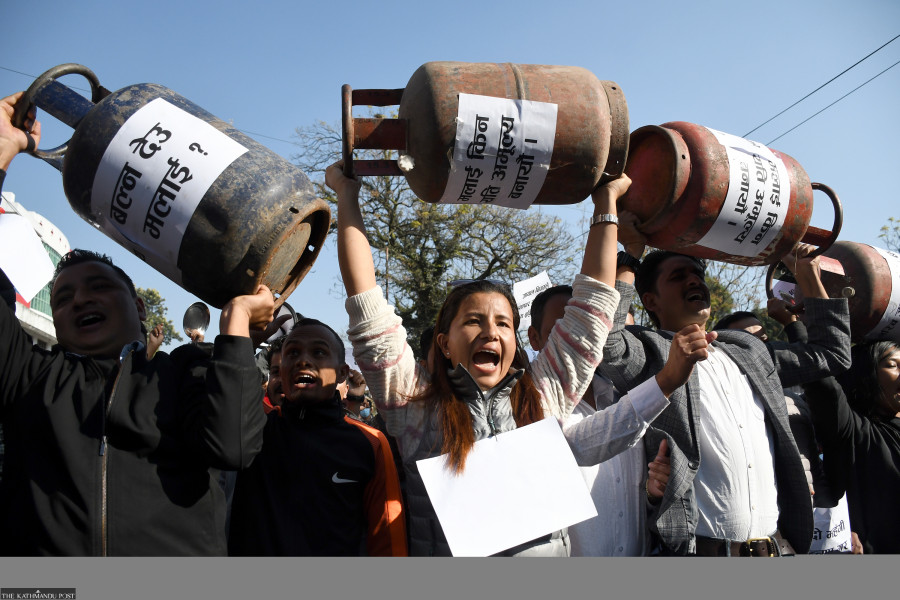
Students protest against the recent fuel price hikes at Exhibition Road in Kathmandu on Sunday. POST PHOTO: ANISH REGMI
It is back to the bad old days for Nepal Oil Corporation when the usually loss-making, cash-strapped public enterprise used to ask the government for handouts to import petroleum products.
The state-owned oil monopoly has written to its line ministry to use the price stabilisation fund as there are no signs of global oil prices coming down while local gasoline prices have been repeatedly jacked up to reach all-time highs.
It has also asked the government for loans to finance imports.
According to Nepal Oil Corporation, if the government allows the use of the price stabilisation fund, the burden of rising fuel prices will be shared between the public and the government—consumers will pay half of the increased cost while the fund will cover the rest.
Public anger against soaring gasoline prices has been growing. Various student unions and political parties, including the ruling coalition the Nepali Congress and the Communist Party of Nepal (Maoist Centre), have been holding protests against the price hike since last week.
CPN-UML cadres took out a torch procession against the high cost of fuel in the capital on Friday. They continued their demonstration on Sunday marching through the streets carrying cooking gas cylinders aloft.
In a bid to placate irate demonstrators, Nepal Oil Corporation said it had proposed subsidising fuel using money from the fund. The corporation has so far collected Rs13 billion in its price stabilisation fund, which is enough to finance the extra cost for at least three months.
Binitmani Upadhyay, spokesperson for Nepal Oil Corporation, told the Post that if the government releases the fund, it will ease pressure on the company to some extent.
“We have been incurring a monthly loss of Rs5.24 billion,” he said. The company has a monthly turnover of Rs24 billion.
The state-owned monopoly said it had not imported fuel on credit from its sole supplier Indian Oil Corporation so far, and had been paying for its imports using the massive savings deposited in different banks during days of plenty.
“We have informed the government about the ballooning losses. We are discussing obtaining loans from the government,” said Sushil Bhattarai, deputy managing director of the corporation. “The rise in international prices has been a burden for a long time. Now we have received another hit due to a stronger United States dollar.”
According to Bhattarai, the appreciation of the greenback against the Nepali rupee has caused a financial burden of Rs1 billion monthly. “Despite much pressure, there is no shortage,” he said.
The corporation set up the price stabilisation fund in 2014, a reserve created to absorb extreme volatility in selected commodity prices and avoid hurting the consumer. There is around Rs13 billion in the fund, the corporation said.
“The corporation is in a difficult situation as prices of fuel have been increasing steeply,” he said. “We are not sure how high prices will go.”
On November 10, Nepal Oil Corporation increased the prices of petroleum products. The price of petrol has reached Rs136 per litre and diesel and kerosene now cost Rs119 per litre.
Aviation fuel sold to international carriers has reached $895 per kilolitre, and fuel sold to domestic airlines has reached Rs101 per litre. The price of cooking gas has shot up to Rs1,575 per cylinder.
Petrol is inching towards 2014 record high price of Rs140 per litre. The oil supplier has revised fuel prices 14 times since January.
Upadhyay said that there was no possibility of rolling back gasoline prices. “But using the stabilisation fund will enable the corporation to avoid increasing prices further for a certain period.”
As per international media reports, the price of fuel is expected to reach $90 per barrel by the end of 2021.
“We cannot predict to what level the price will increase in the coming days,” he said.
Even after increasing prices, the corporation said it was incurring a loss of Rs17.58 on every litre of petrol sold, Rs13.14 on every litre of diesel and Rs657.84 on every cylinder of cooking gas.
In 2014-15, Nepal Oil Corporation had announced a dramatic turnaround posting a profit of Rs18 billion after five straight years of losses.
Since September 29, 2014, the company has been implementing the auto pricing system on petrol, diesel and aviation fuel.
The state-run oil monopoly earned a net profit of Rs15 billion in 2015-16 largely thanks to a fall in crude oil prices in the international market.
The surging profits allowed the corporation to repay its loans worth Rs32.64 billion to the government and other financial institutions, enabling it to declare itself a debt-free institution.













